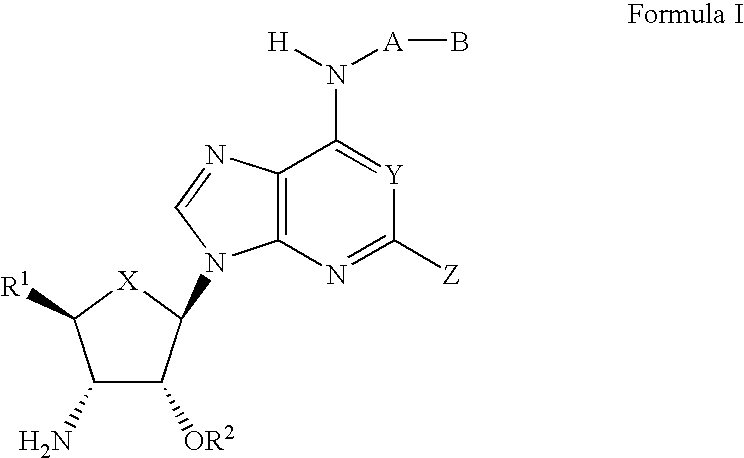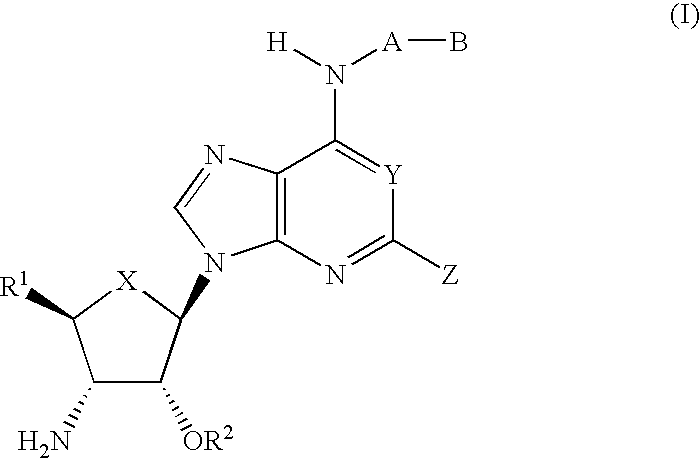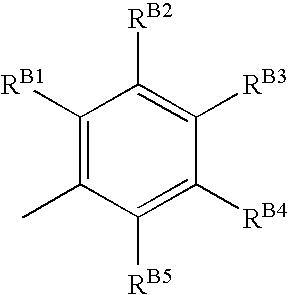Compounds for the treatment of ischemia
a technology of ischemia and compound, which is applied in the direction of anti-noxious agents, drug compositions, cardiovascular disorders, etc., can solve the problems of sudden death, myocardial infarction or congestive heart failure, etc., and achieves the effects of increasing in vivo half-life, and reducing the risk of ischemia
- Summary
- Abstract
- Description
- Claims
- Application Information
AI Technical Summary
Benefits of technology
Problems solved by technology
Method used
Image
Examples
examples
General Experimental Procedures
[0414] NMR spectra were recorded on a Varian XL-300 (Varian Co., Palo Alto, Calif.), a Bruker AM-300 spectrometer (Bruker Co., Billerica, Mass.) or a Varian Unity 400 at about 23° C. at 300 or 400 MHz for proton. Chemical shifts are expressed in parts per million downfield from tetramethylsilane. The peak shapes are denoted as follows: s, singlet; d, doublet; t, triplet, q, quartet; m, multiplet; and bs, broad singlet. Resonances designated as exchangeable did not appear in a separate NMR experiment where the sample was shaken with several drops of D2O in the same solvent. Atmospheric pressure chemical ionization mass spectra (APCIMS) were obtained on a Fisons Platform II Spectrometer. Chemical ionization mass spectra (CIMS) were obtained on a Hewlett-Packard 5989 instrument (Hewlett-Packard Co., Palo Alto, Calif.) (ammonia ionization, PBMS). Where the intensity of chlorine or bromine-containing ions are described the expected intensity ratio was obse...
preparation b
(2S,3S,4R,5R) 3-Azido-5-{6-[(3-benzyloxy-6-methyl-pyridin-2-ylmethyl)-amino]-purin-9-yl}-4-hydroxy-tetrahydro-furan-2-carboxylic Acid Methylamide (Compound B1)
[0420] 3-Benzyloxy-6-methyl-pyridin-2-yl methyl amine (41 mg, 0.17 mmol), (2S,3S,4R,5R) 3-azido-5-(6-chloro-purin-9-yl)-4-hydroxy-tetrahydro-furan-2-carboxylic acid methyl amide (50 mg, 0.15 mmol), ethanol (5.0 mL), and triethylamine (100 μL, 0.73 mmol) were combined and heated to 70° C. overnight. The mixture was concentrated and the residue was dissolved in dichloromethane and reconcentrated 3× to afford a quantitative yield of the title compound as a colorless foam. MS 531 (M+H)+.
[0421] Compounds B2-B12 were prepared according to the general procedure described above for the preparation of Compound B1 using the appropriate amine.
Sample No.Compound NameB2(2S,3S,4R,5R) 3-Azido-5-[6-(2,2-diphenyl-ethylamino)-purin-9-yl]-4-hydroxy-tetrahydro-furan-2-carboxylic acid methylamideB3(2S,3S,4R,5R) 3-Azido-5-[2-chloro-6-(2,5-dimet...
preparation d
Alternate Preparation of (2S,3S,4R,5R)3-azido-5-(6-chloropurin-9-yl)-4-hydroxytetrahydrofuran-2-carboxylic Acid Methylamide (Compound C1)
[0423] To a solution of acetic acid 4-azido-2-(6-chloropurin-9-yl)-5-methylcarbamoyl-tetrahydrofuran-3-yl ester (1.1 g, 2.9 mmol) in anhydrous methanol (100 mL), cooled to 0° C., was added triethylamine (1.2 mL, 8.6 mmol). The solution was stirred for 2 h at room temperature, under anhydrous conditions. After removal of solvent by rotary evaporation, the resulting solid was purified via flash chromatography (7% MeOH / CH2Cl2) to yield the title compound as a white foam.
[0424] C11H11ClN8O3; MW 338.72; MS 339.1 (M+H)+; 1H NMR (400 MHz, DMSO-d6) δ 9.01 (s, 1H); 8.81 (s, 1H); 8.22 (quart, 1H, J=4.2 Hz); 6.41 (dd, 1H, J=5.2 Hz, J=2.1 Hz); 6.12 (d, 1H, J=5.2 Hz); 5.03 (quart, 1H, J=5.2 Hz); 4.57-4.47 (mult, 1H); 4.41 (d, 1H, J=3.9 Hz); 2.61 (d, 3H, J=4.2 Hz).
Preparation E
(2S,3S,4R,5R)3-Azido-5-(6-chloro-purin-9-yl)-4-acetoxy-tetrahydro-furan-2-carboxyl...
PUM
| Property | Measurement | Unit |
|---|---|---|
| temperature | aaaaa | aaaaa |
| temperatures | aaaaa | aaaaa |
| temperature | aaaaa | aaaaa |
Abstract
Description
Claims
Application Information
 Login to View More
Login to View More - R&D
- Intellectual Property
- Life Sciences
- Materials
- Tech Scout
- Unparalleled Data Quality
- Higher Quality Content
- 60% Fewer Hallucinations
Browse by: Latest US Patents, China's latest patents, Technical Efficacy Thesaurus, Application Domain, Technology Topic, Popular Technical Reports.
© 2025 PatSnap. All rights reserved.Legal|Privacy policy|Modern Slavery Act Transparency Statement|Sitemap|About US| Contact US: help@patsnap.com



